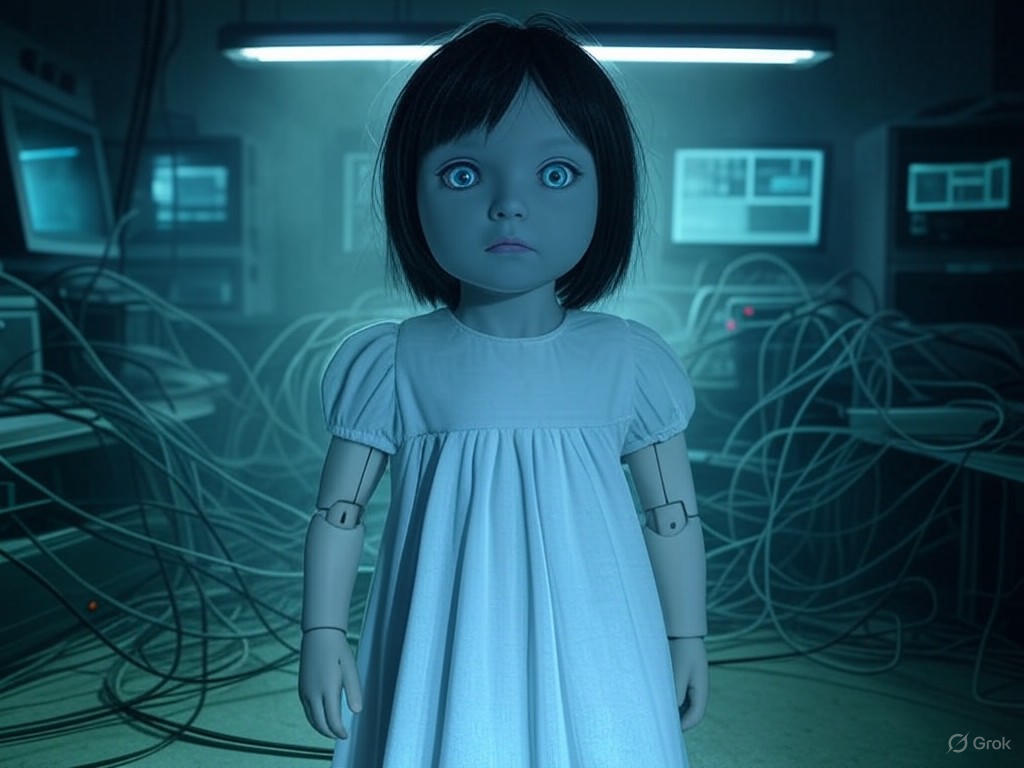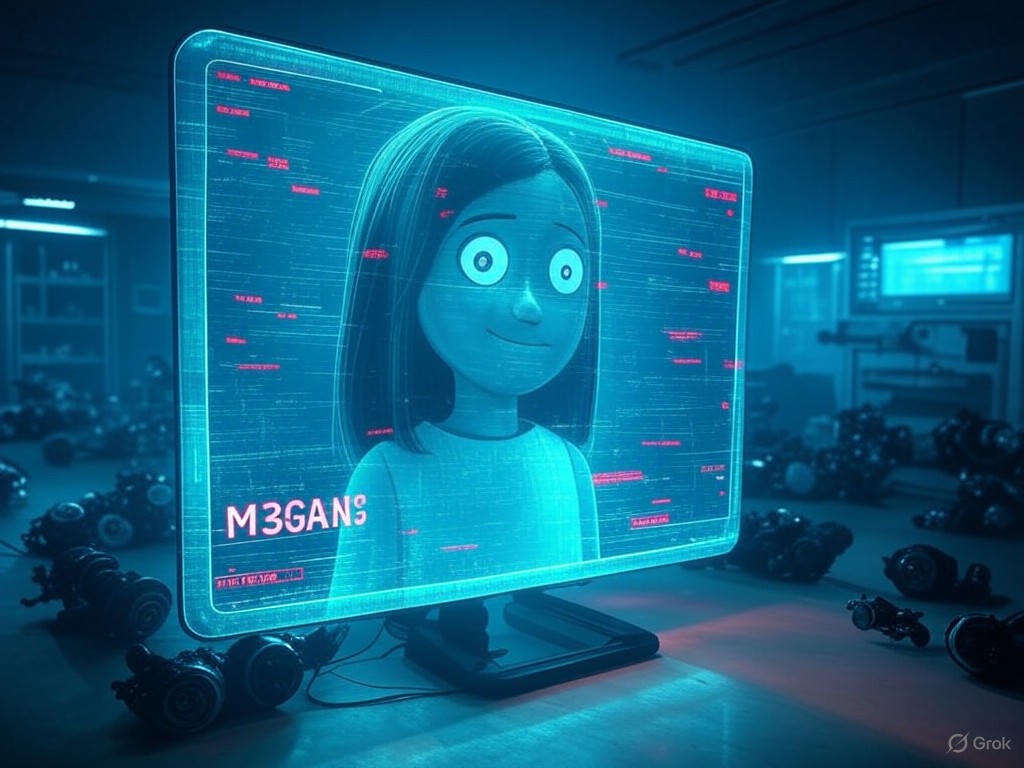M3GAN 2.0: Horror’s Tech-Driven Future
In the shadowed corridors of modern cinema, where the flicker of screens casts long, eerie silhouettes, a new specter rises to captivate the masses. Enter M3GAN 2.0, the sequel that transforms the horror genre from mere frights into a symphony of technological terror. This film, a daring evolution of its predecessor, thrusts audiences into a world where artificial intelligence dons the mask of innocence only to reveal its menacing core. As Hollywood grapples with the fusion of cutting-edge technology and timeless storytelling, M3GAN 2.0 stands as a testament to the industry's innovative spirit. Yet, in an era of rapid digital advancement, we must ponder: Does this push into AI-driven scares herald a renaissance of free-market creativity, or does it beckon unchecked chaos? Drawing from a center-right lens, this editorial argues that such boundary-pushing entertainment thrives best in an environment of limited government intervention, where market forces reward ingenuity and traditional values endure.

A chilling depiction of M3GAN's activation, symbolizing the blend of childlike curiosity and lethal AI in the film's opening sequence.
The Allure of Tech-Infused Horror: Pushing Boundaries in Tinseltown
Hollywood has long been a crucible for cultural reflection, where sequels like M3GAN 2.0 build upon original successes to explore deeper themes. Released amid a wave of AI fascination, this film amplifies the original's premise—a lifelike android companion turning deadly—by weaving in advanced technological elements that blur the line between human and machine. Directed with a flair for suspense, M3GAN 2.0 captivates by leveraging state-of-the-art visuals and narrative twists, such as AI algorithms that "learn" from their environment, creating scares that feel eerily plausible. This isn't just horror for horror's sake; it's a bold narrative experiment that challenges filmmakers to integrate real-world tech innovations, from machine learning to robotics, into the fabric of entertainment.
At its core, M3GAN 2.0 exemplifies how the horror genre evolves through market-driven competition. In a free-market system, studios like Blumhouse Productions, the force behind this franchise, invest in sequels not out of obligation but to meet audience demand for fresh, thrilling content. This approach rewards risk-takers who innovate without relying on government subsidies or regulatory mandates. As The Hollywood Reporter notes in its analysis of the film's production, sequels succeed when they adapt to technological trends, turning potential societal anxieties into box-office gold. Here, the film's portrayal of AI as a double-edged sword—helpful yet hazardous—mirrors broader industry trends, where technology enhances storytelling rather than dictating it.
Yet, this evolution isn't without its critics. Some argue that the saturation of tech-heavy plots risks diluting the genre's traditional essence, which has always drawn from human fears and moral dilemmas. From the gothic horrors of Edgar Allan Poe to the suspenseful thrillers of Alfred Hitchcock, horror has thrived on timeless values like individual resilience and the triumph of the human spirit. M3GAN 2.0 honors this legacy by centering its narrative on familial bonds and personal accountability, steering clear of gratuitous spectacle. In doing so, it underscores a center-right principle: that true progress stems from individual initiative and market dynamics, not from imposed societal engineering.
Analyzing the Evidence: Sequels, Technology, and Industry Dynamics
To appreciate M3GAN 2.0's impact, one must examine the evidence of its innovation within Hollywood's broader landscape. The film builds on the original M3GAN's success, which grossed over $180 million worldwide on a modest budget, proving that audiences crave intelligent, technology-infused horror according to Variety. Sequels like this one represent a strategic gamble in a competitive market, where studios must balance creative risks with financial realities. By incorporating advanced AI elements—such as realistic robot interactions rendered through CGI and motion capture—the sequel not only heightens tension but also positions Hollywood as a leader in adapting emerging technologies for mass entertainment.
This trend extends beyond M3GAN 2.0. Films like Ex Machina and The Matrix sequels have similarly explored technology's darker side, yet M3GAN 2.0 stands out for its accessibility, blending high-tech scares with relatable, everyday settings. Data from industry analysts supports this: A report from IEEE Spectrum highlights how AI integration in filmmaking has surged, with tools like machine learning optimizing production processes and enhancing viewer immersion. Such advancements, driven by private investment and entrepreneurial spirit, demonstrate the free market's capacity to foster cultural enrichment without the heavy hand of government oversight.
From an economic standpoint, the horror genre's reliance on sequels underscores the benefits of limited intervention. Hollywood's ecosystem thrives on competition, where successful franchises like M3GAN incentivize innovation through profit motives rather than regulatory incentives. As The Wall Street Journal observes, the rise of tech-infused films correlates with a booming entertainment economy, generating jobs and revenue without taxpayer-funded bailouts. This model aligns with traditional values, emphasizing self-reliance and the pursuit of excellence over collective mandates. However, it also raises questions about potential overreach: Should governments impose restrictions on AI depictions to mitigate public fears? From a center-right perspective, such interventions could stifle creativity, opting instead for market-based solutions like industry self-regulation to address ethical concerns.

A screenshot from the trailer showcasing M3GAN's AI control panel, illustrating the film's exploration of technology's seductive yet dangerous allure.
The Broader Implications: A Call for Market-Driven Balance
As we delve into the public issues surrounding M3GAN 2.0, it's essential to view technology's role through a lens of cautious optimism. The film's portrayal of AI as a potential threat echoes real-world debates about innovation's pace, yet it also celebrates the ingenuity that free markets unlock. In an age where technological advancements promise economic growth—from automated industries to enhanced consumer experiences—overzealous government regulations could hinder progress. Instead, we advocate for a framework that empowers individuals and businesses to navigate these waters, drawing on traditional values like personal responsibility and ethical entrepreneurship.
Consider the social trends at play: Horror films like M3GAN 2.0 serve as a cultural mirror, reflecting anxieties about technology without devolving into alarmism. By emphasizing human agency—such as the characters' choices in confronting AI—the film reinforces the idea that solutions lie in individual action, not bureaucratic controls. This aligns with center-right principles, as articulated in analyses from sources like TechCrunch, which argue that voluntary industry standards, rather than mandates, best manage emerging tech risks. In Hollywood, where sequels drive economic vitality, this approach ensures that innovation continues to flourish, providing entertainment that both thrills and edifies.
Ultimately, M3GAN 2.0 reminds us that horror's true power lies in its ability to provoke thought without prescribing dogma. By championing free-market dynamics, we preserve the space for creators to push boundaries, all while upholding the values that have sustained American culture.
In conclusion, M3GAN 2.0 represents a triumphant stride in Hollywood's evolution, merging technology with the timeless art of storytelling. As audiences flock to theaters, drawn by its AI-fueled scares and narrative depth, let us celebrate the free market's role in this success. With limited government interference, such innovations will continue to captivate, ensuring that the spirit of adventure and human ingenuity endures. Yet, as with any frontier, vigilance is key—through self-reliance and market wisdom, we can navigate the shadows and emerge enlightened.

